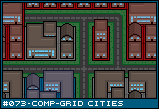|
Mechanic #073 - Comp-Grid Cities |
 | Posted: 01/13/08
A tactics game where one takes over a city, block by block, gaining bonuses. |
![[city1.png]](set04/img/entry073-city1.png)
The city is broken down into separate blocks, each block containing multiple buildings. You begin the game in control of a single building. Each turn you may attack a neighboring building and conquer it. Doing will put you into a tactical map containing the building you are coming from with your units positioned and the enemy's building with his units in it. Inside each building is a capture point. If you manage to capture the opponent's capture point, you win the building (and vice versa).
The goal is to move across the map, collecting buildings, and eventually taking over the entire city. One thing to keep in mind is that this is not a defensive game. The enemy will never attack your own buildings. You will only lose terrain by attacking an enemy building that is too well stocked.
This being a composition grid entry, one might immediately recognize that buildings can be larger than a single cell of the current block. Attacking a neighboring building that is larger than one cell will put the entire building into the tactical map. Likewise, attacking enemy buildings over empty terrain (like roads or empty lots) will put those lots into the tactical map as well (so attacking across the street will go your building, road, their building).
Each cell of the map is a single resource unit. You have a single character that you will always have available to you. Each resource unit will have four generic units that will fight alongside him. A building that takes up multiple cells will contain multiple resource units. A three cell building will contain 12 units total (plus your hero). A small building attacking a large building will be at a disadvantage in the number of units.
You do not get to decide which types of units are in each building. The four that are there is static for each terrain feature, regardless of who owns it. So if a single cell building contains two gunmen, an assassin, and a field marshall when you attack it, when you attack from it, you'll have two gunmen, an assassin, a field marshall, and your hero.
Also, being a composition grid entry, you might expect that each building contains some sort of effect that it can convey to neighboring buildings. For instance, one building might have a special unit (like a hitman or something) that is available to any allied building touching it. So if you attack from that building or one of the four neighbors, you'll have the four generics, the hitman, and your hero. The same applies to the enemy. If he owns that hitman building, he'll have access to that unit on his buildings when he is attacked.
In addition to building buffs, there are buffs that are gained by owning an entire city block. Owning all the buildings in a block could do something like increase the level of all the friendly units on the map, increase their attack potential, or their defense. Losing even one building in a block will lose that buff for all, so it could be potentially important to find the week spot in the armor first before launching a full assault against some place.
The strategy part of the game (above and beyond the tactics map) is taking over important buildings to weaken the enemy and strengthen your own. Knowing which building to attack and from where is a major deciding factor in the game. The final building in the city will likely have heaps of buffs on it that turn it into an impregnable fortress, and unless you can take down the buildings affecting it, it will be impossible to conquer.
Not all buildings are created equal. Some buildings may have reduced resources (like less units guarding it or weaker ones) in favor of creating a stronger buff. Buffs (and debuffs) can affect not only neighboring buildings, but also all the buildings in the block, or along a horizontal or vertical line (all friendly buildings on the same line do extra damage or something). While city block bonuses are universal, individual buildings have their benefits limited to the single block they are contained in.
Another possibility is that some buildings will make available certain trigger actions, like a card that will poison your opponents for a single battle or a card that will nullify the effects of a single building for a turn. These cards are only available while you own the particular building which produces it, and once you've used it, it will take several turns for the building to produce another one.
Frankly, this idea began with the idea of launching attacks between buildings defining a tactical map, but one could just as easily ignore that aspect and replace it with weighted dice rolls. This entire system could, with some effort perhaps, become a reasonably entertaining multiplay board game - a sort of version of Risk where each territory gains you special abilities. Since building effects only really make a difference within a single city block, keeping track of what building is affecting what other buildings may not be as taxing and dry as it seems (especially if you keep blocks to fewer buildings in the first place). |